The history of the German Spitz from the 20th century
Milestones from 1900 to the present

"Strangely, this oldest Germanic dog breed, which has been passed down from prehistoric pile-dwelling times to the present without any specific breeding, is avoiding to modern dog show culture. As often on my walks through town and country in Württemberg, I encounter these archetypal figures in rare perfection ; on the other hand, I haven't seen a magnificent specimen at shows for years; it just seems to thrive better on the country road than in the salon."
Breed judge Kull said this at the dog show in Munich in 1895 and got to the point: at a time when many hunting dog breeds already had long pedigrees and dog clubs increased as hell, it seemed that "especially for the Spitzes the most inadequate understanding of all dog breeds prevails. No wonder, when dogs were awarded first and honorary prizes that only resemble a Spitz at 100 meters."
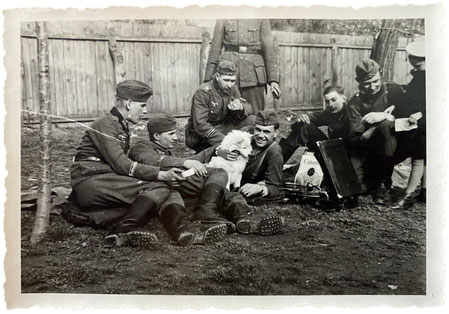
Towards the end of the 19th century, the large Spitzes were looked after by the German Shepherd Club "Phylax" (founded in 1891), as they were considered sheepdogs in many places, and the small Spitzes were looked after by toy dog clubs, until 1899 the "Verein für Deutsche Spitze" (German Spitz Club) on the initiative of Mr. Charles Kammerer from Vienna was founded. A separate Spitz studbook was immediately introduced (DSpZB), the first breed characteristics followed in 1900, a brochure about Spitz in 1905 and a club newspaper was published from 1908 onwards. However, the foundations of the club, statutes and the maintenance of its own stud book were decided on in 1900. Since then, there have been special breed judges only for the German Spitz, but at the time those judges also had to be club members. The general number of members was still very modest at that time, and fell massively after the First World War.
At the third general meeting of the German Spitz Club in September 1902, the first changes to the previously established breed characteristics were discussed. So the word “gray” was deleted from the Wolfspitz standard, there were no longer any gray Wolfsspitzes, but only “the Wolfsspitzes” with clear distinction. This eliminated all other colors for the Wolfsspitzes - such as brown ones.
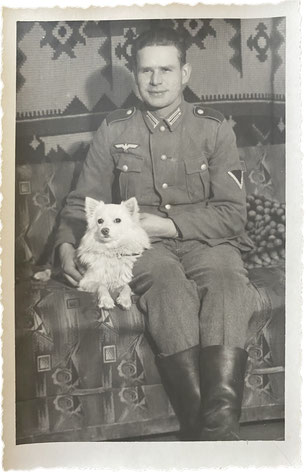
From 1905 onwards it was decided to breed the Spitz for larger size; the rule was "the bigger, the better", but only if the overall appearance did not suffer from the size. Wolfspitzes should now be at least 45 cm tall, Giant Spitzes should be at least 40 cm. Until then, the Giant Spitz, with an ideal size of 27 - 40 cm, corresponded more closely to today's Mittel Spitz, which did not yet exist at the time; The introduction of the “Mittel Spitz” class was also rejected in 1955.
At the general meeting on July 16, 1906, Carl Wolfsholz also proposed that brown, blue and fox red be recognized as color varieties, but that spotted animals be excluded from the Giant Spitzes (not so with the small Spitzes). It was then decided to recognize not only all colors - including the piebalds that were listed under "different colors" - but also all sizes. It was also decided that from now on dogs between 27 cm and 39 cm will also be eligible for entry and prizes on shows. Furthermore, it was decided that these dogs - essentially the Mittel Spitz size at the time - should be shown at exhibitions together with the Giant Spitz dogs, as long as there are no separate classes for this middle size category.
The Wolfsspitz was always clearly distinguished from the other Spitz by its size and stature - but also by its color and various other characteristics - and was considered by many to be the oldest type of Spitz (Jean Bungartz). In a club brochure about the general meeting of 1905 it is described that the Wolfsspitz (apart from its size) should differ from the Giant Spitz mainly in its cranial shape and that in the future a uniform head type, the so-called "Wolfsspitzkopf", should be aimed in breeding.
By 1910, Spitzes were bred in a whopping seven dog clubs in Germany. From reports in magazines of the time, it is known that the clubs all held their own dog shows:
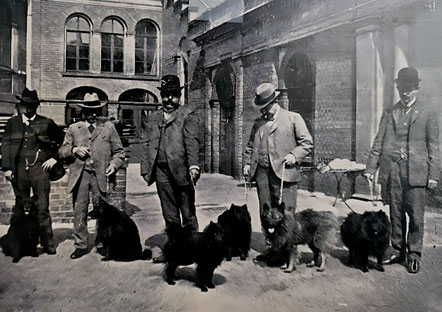
- The"Verein für Deutsche Spitze", Elberfeld
- The "Deutscher Spitzer-Klub", Frankfurt/Main
- The "Schoßhundklub Berlin"
- The "Erste Mannheimer Zwergspitz- und Schoßhund-Klub"
- The "Vereinigung für Züchter und Liebhaber Deutscher Spitze", Frankfurt/Main
- The "Erster Württembergischer Schoßhund-Klub Stuttgart E.V."
- The "Schoßhundklub Ludwigshafen a. Rhein"
Towards the end of the 19th century it was the case that in principle every innkeeper could organize a dog show in his beer garden. He charged a small fee and someone judged the dogs and handed out the prizes. Of course, this approach opened the door to all sorts of chatter, which is why the suggestion to introduce exhibition rules came very early in these circles. In 1878 an association for the refinement of purebred dogs was founded. Clubs that did not keep their own studbook turned to this. Delegates from a total of five clubs met there and the “Delegierten Commission” [(DC) Delegates Commission] was created. It was the commission who introduced the first German studbook. It was a complete replica of the English "Kennel Club Stud Book". Since this was seen as a danger that English dog breeds were being preferred, the German clubs, as owners of their own studbooks, founded their own organization in 1906, which they gave the name "Kartell der stammbuchführenden Spezialklubs für Jagd- und Nutzhunde" (Cartel of special clubs for hunting and working dogs) that kept studbooks and which - in addition to the German Spitz Club - most of the other Spitz clubs also joined in 1910. In practical terms, the cartel was the forerunner of the German VDH ("Verband für das Deutsche Hundewesen" - Association for German Dogs). At that time, these clubs affiliated with the "Kartell" bred the German Spitz in “only” three varieties:

- Wolfspitz (45 cm or larger)
- Giant Spitz (around 40 cm)
- Miniature Spitz (maximum 28 cm)
At the “Kartelltag” (Cartel Day) in 1920, the German Spitz Club was finally granted registration privileges for all Spitze.
At the general meeting in the same year, the training of guide dogs was included in the statutes as a further purpose of the Spitz Club.
In 1922 the term "Toy Spitz" was dropped and until 1974 there was only the Miniature Spitz - but with the same size of up to 26 cm. In 1933, the wording “the smaller, the better, but not a cripple ” was also deleted from the standard.
At the 24th general meeting in Cologne in 1936, the representative of the German Spitz Club, Dr. Manger, warns against breeding the Miniature Spitzes too small and the Wolfsspitzes too large, otherwise they would suffer a loss in type and temperament. This was generally agreed. Unfortunately, it was also noted that the large white and black Spitzes have declined sharply in number and quality in recent years and the hope was expressed that the distribution and breeding improvement of these species, which were so popular years ago, would be successful. It was also noted:
"Our breed characteristics are still the same as they were established in 1900. As our Spitz was and is as an original German breed, so it should remain in territorial instinct, nature and character. The task of our breeders must be to ensure these three characteristics in the Spitz and to combine it with beauty."
From January 1, 1939, the veterinarian Dr. Miller is the editor of the club newspaper “Der Deutsche Spitz”. This man stood out because he not only worked particularly hard to promote white, black and brown Giant Spitz breeding, but also paved the way for the introduction and recognition of the Wolfspitz as a service dog for police and army.
There were repeated merger negotiations between the "Kartell" and "DC", but without results. In 1933, all dog clubs that kept the studbook - including the cartel - had to dissolve by order; The clubs that did not keep a studbook were banned from 1935 and with it the "DC". The reorganization of the entire dog clubs by the National Socialists went very quickly: the "Kartell", the "DC" and the "Verband von Vereinen zur Prüfung von Gebrauchshunden zur Jagd" (Association of Clubs for the Testing of Working Dogs for Hunting) were combined to form the "Reichsverband für das Deutsche Hundewesen" (Reich Association for the German Dog Clubs). The breed associations were renamed “Fachschaften” and also subordinated to the Reichsverband. The last general meeting of the German Spitz Club took place in Cologne on April 25, 1936. From then on, there are no more documents for the club until the first general meeting after the war (1947).

In Austria, the German Spitz was the most preferred dog par excellence until the First World War. They were mostly bred without cynological organization and primarily in the colors black and piebald. After 1918, however, the Spitz was replaced by other dog breeds, but the systematic breeding of the Toy Spitz began at this time, as more and more people lived in cities and the small Spitz was easier to keep there. An important link to the German Spitz population was Mr. Charles Kammerer, one of the founders of the "German Spitz Club", who also bred first-class black Toy Spitz himself. Due to Kammerer's death and due to the Second World War, Spitz breeding in Austria suffered serious setbacks: the Giant Spitz more or less extinct there - there was still one single black male named "G'spenti v. Gude" left, with whose death the Giant Spitz became completely extinct in Austria. And things were very bad for the Toy Spitz, too. They also had only one black stud dog, a German import. The leader of the Austrian Spitz Club, Ms. Linhart, finally ensured that they worked together again with the German breeders and thus stopped the demise of the Toy Spitz in Austria.
In Switzerland, the German Spitz became quite popular around the turn of the last century, especially among the mountain farmers. At that time, the German Spitz was still popularly referred to as a “wolfhound” [15]. The then president of the Swiss Spitzer Club, Jules Hoffmann, reports that in the past, mountain farmers often mated mountain foxes with their Spitzes in order to bring out sharper and more aggressive dogs. Only through supervised breeding and the founding of the Swiss Spitzer Club were such methods stopped. Mainly Toy Spitz and Giant Spitzes were bred. As in Austria, the First World War almost completely stopped Spitz breeding, as did the Second World War. After that, it took almost 10 years to gently draw threads of friendship towards Germany again and to expand this into a fruitful collaboration.

For the Germans, the period from the end of the war until the currency reform in June 1948 was characterized by the fight for survival. Money was worthless, the only stable currency was cigarettes. Nevertheless, the number of puppies registered in the clubs rose from around 1,000 registered puppies in 1938 to around 2,500 in 1944. Only the year 1945 brought a slump, where the number of puppies fell to around 500, then to 2,500 in 1946 In 1947 the number increased to 4,000 dogs. However, there was a sheer survival strategy behind this, because Spitz puppies were of course a sought-after exchange item for the townspeople during their so-called "Hamsterfahrten" (means "hamster-tours": they traveled to the countryside to swap as much food as possible) to the farmers. There are old stories of city dwellers who, after the war, rushed to the countryside in handcarts with six or more puppies to trade potatoes or other food for the dogs. Of course, this development was absolutely not ideal for breeding. The bitches were exploited to the utmost and every (!) puppy was raised. It then took many years until the mistakes made here were ironed out. [12]
From 1948 onwards, German Spitzes were presented again at dog shows - 632, an unprecedented number. 305 Spitzes alone were exhibited at the special dog show on April 10, 1948 in Mühlheim an der Ruhr. In later years, however, this number corrected downwards again to around 300.
Looking back, it was probably not that easy to turn this still very original breed, which had only just jumped off the coach seat, into a modern dog with a uniform type. Nevertheless, even before the breed standards were published, great importance was attached to, for example, a full ruff and a hairy tail. Attention has always been paid to a square building; elongated Spitzes were considered unsuitable for breeding. In contrast to later standard regulations, the Spitz with a round, domed skull was preferred at that time. Animals with flat skulls (apart from the Wolfspitz) were disqualified. There was pretty much everything you could imagine in terms of colors: white, cream, golden yellow, fox red, brown, black, blue, grey-clouded and piebald Spitzes were available back then. At that time, the focus when breeding the large Spitz was still on the standard colors black, white, brown and gray clouds, as the coat color of the dogs was linked to their tasks.

After the turmoil during the war and in the post-war period, which also had a major impact on dog breeding, the Miniature Spitz and Wolfspitz populations recovered quite quickly, but the Giant Spitzes population did not. The population of the white Giant Spitz in particular was so decimated that their breeding was in principle only possible with a high level of inbreeding. It is important to note that it was only the German Spitz Club's Giant Spitzes who virtually disappeared from the scene. At that time, there were still more than enough terrific dogs from the countryside and farm dogs, but these were ignored by the German Spitz Club.
At that time, the Braunschweig Spitz club group placed an advertisement in the local daily newspaper to invite interested parties to a meeting of the local group, which was then attended by 45 people. Almost all participants subsequently agreed to join the club. Numerous of these new members probably had Spitzes - but without pedigree. Some of these had been lost due to the chaos of war, some had been bred without entry in the studbook. Efforts on the part of the Braunschweig group to have these animals subsequently registered and thus used for breeding unfortunately failed due to the German Spitz Club's regulations to stop the registration of Spitzes in the course of 1947, so the stud book was closed immediately after the war!
One kennel particularly stood out in the subsequent "rescue" of the white Giant Spitz, namely the kennel "von der Norisschanze" from breeder Willy Wintzheimer. He accomplished the miracle of successfully bringing the white Giant Spitz out of obscurity - without any existing breeding stock. At that time, Mr. Wintzheimer created Giant Spitzes of an almost astonishing size! One of these “pleasantly big Giant Spitzes” [2] was - to the club's dismay - dismissed from the ring by the Dutch judge at an international dog show in Utrecht with a score bordering on disqualification, on the grounds that the dog (the then World Winner) would not be a purebred Spitz, but a Samoyed-Spitz-crossbreed. [3] How on earth did the judge come up with this? 😬
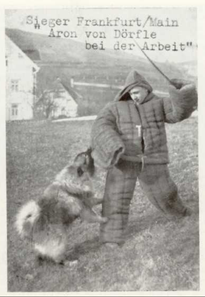
The first Spitz club's meeting after WW2 took place on September 20, 1947, in Cologne. Not only was it decided to increase the minimum age for stud dogs (small Spitzes 15 months, big Spitzes 18 months), but all colors were also permitted. Only pure colored animals with white paws, blazes or chest spots disqualified. In addition, the stud book was closed. At this point, the club was already publishing a kind of club magazine again. In one of these circulars from 1947, the then stud-book keeper Dr. Heller the various brown tones of brown Giant Spitzes, which were available in the colors rust-brown, brown-yellow-clouded, cinnamon-colored, amber-colored, brown-clouded, red-brown-clouded, orange and cream-colored, brown and cream-colored. Only two animals were correctly described as “brown”. Another topic in this magazine concerns the test of. At that time, the “Aron vom Dörfle Prize” was awarded to the most severity Spitz. Dr. Heller reports that he has received countless letters demanding selection not only for form value, but also for severity and firmness of character. In fact, you can read a lot about good or lack of severity in the judges' reports of the time.
On April 1, 1955, at an FCI conference, at the request of the then first chairman of the German Spitz Club, Fritz Hess, it was decided that the German Spitz would be judged according to the German standard in all countries belonging to the FCI.
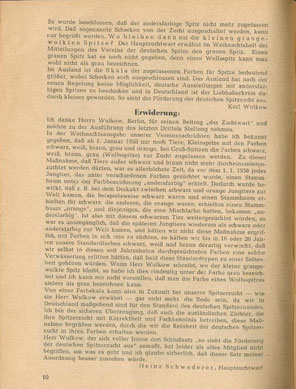
Until then, all colors were allowed, but with the introduction of pure color breeding on January 1, 1958, the breeding of different colors was forbidden, with one exception: the pairing of black Giant Spitzes with Wolfsspitzes remained permitted. In addition, the term “different colored” was no longer used, which effectively eliminated piebald animals. Only the pure colors black, white, brown, gray and orange were permitted for all Spitz varieties. This measure was intended to counteract the increasing watering down of the various colors, but - especially given the small number of Giant Spitzes - it brilliantly overshot the mark. Although the idea behind this measure cannot be dismissed, it would certainly have made more sense to continue to allow the mating of different colors under strict conditions.
In 1965 the next step was to separate Wolfspitzes and Giant Spitzes. These were no longer allowed to be bred with each other at all. Here, too, the reason was pure breeding: people wanted to know what they were breeding and what exactly was being born. To date, Wolfsspitz litters have produced Giant Spitzes and Giant Spitz litters have produced Wolfspitzes. Or both at the same time. This was because, especially during the Second World War, the Giant Spitzes and the Wolfsspitzes were crossbred with each other in a relatively inflationary manner. In order to deal with this, it was decided to separate Wolfsspitz and Giant Spitz and to ban the mating of both varieties. The elimination of the Wolf Spitz as a possible mating partner at that time brought the Giant Spitz to the brink of extinction for the first time, so it was not exactly well-thought-out in its strict implementation under the circumstances at the time.

Another reason why the Giant Spitz almost became extinct at this time was a toxic combination of ignorance about the nature of the Spitz and the poor training of the dogs. For example, in 1968 it was reported from Switzerland that of the few white Giant Spitzes remaining there, only one (!) died a natural death - all the others were shot! Examples of this: White Giant Spitz "Guido von der Norisschanze" was to be killed at the request of his owner because he had become snappy in situations, in which he has become afraid due to poor upbringing, while "Flora von der Norisschanze" and her son (both rated "Excellent" on dog shows) were shot because their owner came to the hospital for a longer period of time and in his desperation he saw no other way out than to have both dogs killed by the local hunter.
In 1969 the Mittel Spitzes as a variety of the German Spitz were accepted, because after the classification and breeding of the Spitz according to size was recognized, there was a black hole in the size range from 28 cm to 40 cm for many decades. In both cases it was a shame because many good, strong dogs were lost to breeding. So far, the establishment of the Mittelspitz, which has been repeatedly called for, has failed due to the simple question of money, because the Mittel Spitz as the fourth class alongside Giant, Wolf and Miniature Spitz would have resulted in a total of 40 classes at dog shows, the winners of which all received cash gifts at the time. The German Spitz Club of that time simply couldn't afford it.
However, the new regulation (initially as a temporary solution) only applied to Miniature Spitzes that were too large and not to Giant Spitzes or Wolfsspitzes that were too small; these were excluded from the mating process of the Miniature Spitzes. Mating was therefore only permitted between Mittel Spitzes, but the litters were again registered as Miniature Spitz and then transcribed as Mittel Spitz if they were oversized again. This was to continue for six generations.

In addition, between 1969 and 1979, the German Spitz was repeatedly transferred from FCI Group 2b (sheepdogs, guard dogs and protection dogs without working test) to FCI Group 9 (companion and toy dogs). And that's how it happened: In 1969, the VDH had to submit a common group classification for all German Spitzes for the FCI's show regulations (see club magazine no. 14/1969). The question of group classification was forwarded by the VDH to the German Spitz Club - and the main board at the time thought it was the best idea ever to put the German Spitz in the companion and toy dog group according to the meeting on July 27, 1969, and to forward this classification to the VDH. This rather questionable classification was carried out while preserving the nature of the German Spitz, as it has been a companion dog for humans since ancient times, so said to the main board of the German Spitz Club. Classification in the toy dog group would not question his vigilance. Um yeeees.... 🙄
Breeders and club members were outraged! Since the contradictions didn't stop, the decision of the main board was stopped at the meeting on May 31, 1970, and the German Spitz was put back into FCI group no. 2b.
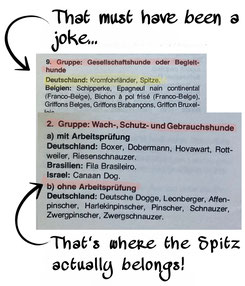
Sheepdogs, guard dogs and protection dogs
2nd group: guard dogs and protection dogs
b) without working trial
German Spitzes in the types:
1. Giant Spitz of all colors
2. Wolfsspitzes
3. Mittel Spitz of all colors
4. Miniature Spitz of all colors
After years of wrangling, the Spitz finally ended up with the toy dog group. This meant that the working dog status was revoked - especially for the large Spitzes - because who wants a lapdog as a police service dog?!
Finally, in 1990 the Swiss cynologist Dr. Hans Räber ("Encyclopedia of Pedigree Dogs") founded FCI Group V (Spitz and primitive types), in which the German Spitz has been represented since then.

In 1974, the "old", new variety of the Toy Spitz was introduced after the name Toy Spitz had been abolished in 1922 in order to be able to include the Pomeranian in the standard for the German Spitz. However, the standard change that was necessary to introduce the Pomeranian was made without a resolution from the German Spitz Club's general assembly, but only by the then main board at their meeting on February 3, 1974. We “acted over the heads of the general assembly”, said then president Werner Jäger. The decision was probably made under pressure from the VDH and led to the expansion of the FCI standard to include the Pomeranian.
The German Spitz Club quickly and soberly realized that Pomeranians were not only not purebred according to their color in their homeland, but - in addition to a different head shape - they also have a different temperament than the Toy Spitz from German breeding. In addition, they criticized the untypical, high tail position and the frequent apple heads of the imported animals, shortened snouts and jaws were also a problem. Some imported animals were unable to breed at 1.5 years old, and many bitches were only able to give birth by Cesarean section. As a consequence of these experiences, an application was made in 1987 to recognize the Pomeranian breed as an independent Spitz breed. In practice, this meant that, according to the German Spitz Club's main board, the Pomeranian should be considered a separate, foreign breed, similar to the Japanese Spitz or the Volpino Italiano. [11] However, the commission set up specifically for this purpose came to no conclusion. As an alternative, the main board - and later the VDH - suggested fusing the Toy Spitz and the Miniature Spitz into one variety in order to expand their breeding base. However, this proposal was gratefully rejected by the majority of those breeders and club members present at the Spitz Club's general meeting in 1990.
Furthermore, in 1974 the breeding of different sizes was banned. This measure, in combination with the color pure breeding of 1958, the separation of Wolfspitzes and Giant Spitzes from each other in 1965 and the addition of the size breeds Mittel Spitz (1969) and Toy Spitz (1974), which further reduced the already very small gene pool of the Giant Spitz, sealed the fate of the Giant Spitz in principle. As early as the 1970s, the large Spitzes were almost on the verge of extinction; the last remaining animals could only be mated with a high degree of inbreeding.
As far as the population of the Giant Spitz variety is concerned, in the 1950s and 1960s around 30 puppies were registered annually. Unfortunately, this changed suddenly at the beginning of the 1970s. In 1973, just one puppy was recorded. After that, things gradually started to improve again, but it wasn't until the end of the 1980s that more than 30 puppies were reported again. At the end of the 20th century, the number of registrations fell back to around 20 puppies. What was really worrying, however, was that from 1997 to 1999 there was not a single black Giant Spitz puppy in Germany's studbook.
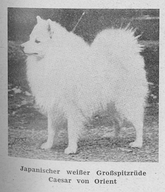
In September 1981 the German Spitz Club received proposals from the Bavarian regional group and the Cologne local group at the general meeting, which proposed the introduction of mandatory Hip Dysplasia (HD) X-rays. It was decided that from January 1, 1983, all Wolfspitzes and Giant Spitzes that are to be used for breeding must undergo HD X-rays. By April 1983, there had been 132 evaluations of X-ray images, which showed that around 33% of the animals X-rayed had medium to severe HD. Dogs with medium to severe HD were no longer allowed to be bred. As early as November 1983, a lawsuit against the Spitz Club was filed with the Cologne Regional Court. The lawsuit was taken all the way to the Higher Regional Court, which ultimately ruled in favor of the Spitz Club. However, I'll just point out the question here if it was that well-thought-out to further reduce the number of the Giant Spitz population, which had already been decimated at the time, by HD X-ray examinations....
In 1984 the German Spitz was recognized in England by the UK Kennel Club.
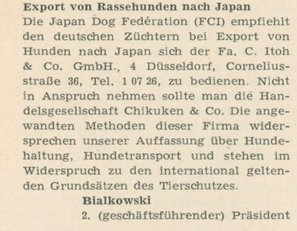
On September 28, 1990, the first Japanese Spitz bred in Germany was born in the kennel "von der Böhmerwies'n". The Japanese Spitz looks surprisingly similar to the white Spitz, but is considered a different breed and was still called the "Nippon Spitz" in the 1950s. However, in old magazines it was also described as a “Japanese Giant Spitz”. Presumably because the term "German Spitz" previously had a very negative connotation due to the prevailing political situation, the Japanese claimed to have bred the Japanese Spitz from the Samoyed. If you really look at the old Japanese Spitz (the "Japanese" Giant Spitz), this theory sounds more than ridiculous, because you can clearly see the German Spitz in them. Still now.
By the way, around 1970, German Spitz were exported to Japan to such an extent that the main board of the German Spitz Club even issued recommendations as to which export companies should be avoided if one wants to ensure reasonable dog transport to the Middle East. However, the Japanese Spitz itself has only been cared for by the German Spitz Club since 1988.
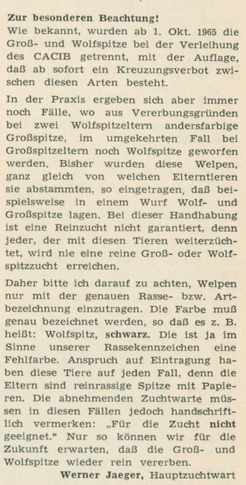
In 1994, the last brown Giant Spitz puppies were born in the "von der Kesterburg" kennel; the brown large Spitz was then considered virtually extinct. It wasn't until 2007 that brown Giant Spitzes appeared again through back crossing, but they are still quite rare.
In 1994 the Keeshonden were finally integrated into the Wolfspitz standard. Because the Verein für Deutsche Spitze, as the association that keeps the studbook, spoke out against an own breed standard for the Keeshond (this would have resulted in the establishment of an independent Keeshond Club), it was commissioned by the FCI to somehow include the Keeshond in the standard for German Wolfspitzes - without even having been asked by the FCI in advance. This was initially not well received by the Spitz Club, as the club itself esteemed the Keeshond as a pure show dog at the time, in complete contrast to the old working dog Wolfsspitz. The German Spitz Club was not really happy about the way the Finns and Swedes in particular did things to follow their aims. The main board received letters from Finland and Sweden which very unreasonably demanded that the German Spitz Club could please accept the fact that the Wolfsspitz is only native to Central Europe, while the rest of the world breeds Keeshonds. That's what I call chutzpah! 😬
The Keeshond was supposed to be listed in advance - on the initiative of some Scandinavian breeders and club officials - as a Dutch breed alongside the Wolfsspitz at the FCI, but the Dutch Spitz Association was not informed about this at all, even though this action directly affected them. A separate standard for the Keeshond had even been developed, but the entire project was then stopped, and the clubs' responsible persons met to find an acceptable solution for everyone.
The main arguments of the FCI commission to set up for a common breed standard were the similarity of the ideal types and the close relationship of Wolfsspitz and Keeshond - evidenced both by the same ancestors and by regular mating. For this purpose, the height at the withers of the Wolfsspitzes (previously up to a maximum of 60 cm) was lowered by 2 cm, while in terms of head shape, in addition to the fox-like head of the Wolfsspitzes, the slightly more rounded head of the Keeshond was also included in the breed standard.
In 2002, two American Eskimo Dog bitches were imported from the USA and bred into the Giant Spitz population. The "Eskies" are descendants of Giant Spitzes that were taken to the USA by German emigrants at the beginning of the 19th century. The Eskimo Dogs still look quite similar to our Spitz dogs, but they have a slightly different nature - and sometimes also a hunting instinct. Although the German Spitz has had to endure some cross-breeding with foreign dog breeds since its arrival in the USA (which made it the American Eskimo Dog), the imported dogs were transferred 1:1 into white Giant Spitz without any conditions.

In 2003, the first VDH litter from a black and white Giant Spitz mating was born in Germany in the kennel “von den fidelen Pfoten” - the first since the introduction of pure color breeding in 1958. The parents were the white bitch "Buffy vom Steingarten" and the black male "Brit z Bratislavy", who gave birth to a litter with three pure black males, a black male with gray markings and a black female with white markings.
Also in 2003, the GEH (Society for the Preservation of Old and Endangered Domestic Animal Breeds) announced that Giant Spitzes and Mittel Spitzes were considered as a domestic animal breeds at risk of extinction. A dog breed is considered endangered if fewer than 300 puppies are registered in the studbook per year. The Giant Spitz is even considered “extremely endangered” and unfortunately almost all the surviving specimens are more or less related to one another. But things aren't looking much better for the Mittel Spitz, which the GEH has classified as "critically endangered".
Since 2019, it has been permitted to crossbreed different colors (with conditions), and the breeding of different varieties is also permitted again; namely between Giant Spitz and Mittel Spitz and Mittel Spitz and Miniature Spitz.
[2] Quote by Hugo Dannacher in „Der Deutsche Spitz“ No. 16, page 9 f.
[3] Interestingly, the German Spitz Club also looked after the Samoyed breeders for several years since 1954.
[4] "Der Deutsche Spitz" No. 19, page 10
[5] "Der Deutsche Spitz" No. 44, page 5
[9] "Der Deutsche Spitz" No. 31, page 3
[10] "Der Deutsche Spitz" No. 56, page 6
[11] "Der Deutsche Spitz" No. 115, page 45
[12] "Der Deutsche Spitz" No. 131, page 16
[13] "Der Deutsche Spitz" No. 67, page 11
[14] "Der Deutsche Spitz" No. 62, page 10
[15] "Der Deutsche Spitz" No. 7, page 32
15.01.2025




